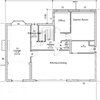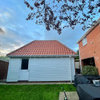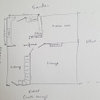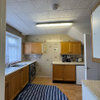Loft conversion and upper floor layout thoughts
The background
I’d like to start out by saying that obviously we will be seeking the services of a structural engineer. I know how many threads like this get posted by people looking for an easy out. I’m just here mainly to write out my thoughts and hopefully get some pointers and opinions so I know what to ask them.
We moved into this house about a year ago, knowing it would need some work. I had hoped that the roof would last another winter and we could get it sorted this summer, but Storm Arwen had other ideas and left us with a significant hole of missing slates on one side. We managed to get it patched, but successive storms have further taken their toll and pushed it up the priority list.

Obviously we could just get it replaced as is, but that seems like a big wasted opportunity when, if we’re going through all the trouble, we could get a lot of things in place for a conversion and end up with an extra room at the end of it.
The house
It’s mid terrace, c. 1890s with solid wall construction – albeit chunky ones that measure about 15”/40cm thick. Originally it was likely just a one up one down, but there’s a 3.8m single storey extension to the rear with the kitchen and a small box room.
The upper floor has been split up to accommodate the bathroom, but the living room is still just one large room, approx 5.4m squared. There’s a stud wall to enclose the staircase but nothing structural.
The roof is supported by a king post, with two separate purlins on each side. Pitch is around 39 degrees, with head height in the centre of the loft being 2.38m.
We paid around 60k for the house just after the first lockdown (we’re in the North East), although similar houses are currently going for around 80k. So while we don’t have any plans to sell in the immediate future, it doesn’t make much sense to go all out on a high end 30k conversion.
We will be contracting the shell of the structure and obviously the electrics, and DIYing as much of the rest as possible. I have enough experience of plastering and joinery to get by.
One thing we are blessed by in this house is high ceilings, 3.2m on the ground floor and 2.9m on the upper floor. So whichever option we go for I would be very tempted to lower the ceiling to around 2.6m, increase the head height in the conversion and also give us the opportunity to board it out before removing the old lath and plaster, minimising disruption to the bedroom below. Presumably this would necessitate some kind of tie between the rafter ends and the lower joists to transfer the horizontal load of the roof.
Conventional wisdom is that the best place for a staircase to the loft conversion is right above the existing one. However, there are a few quirks of this house that are making me think that this may not be the case here. This is the layout of the upper floor currently:

So a staircase above the existing one would take up about 2m of space from the current master bedroom. 860 mm for the staircase, 900 for a hallway, plus a bit for the stud walls and plasterboard. Compounding this, if we ever wanted to extend above the kitchen, the door into that extension would have to be roughly where the bathroom sink currently is, removing at least 1m of space from the bathroom. So we could end up in a weird situation where nearly half of the space on the upper floor is taken up by passageways, and the main bathroom of the house is a small box room with no windows.

The alternative I have in mind is moving the bathroom into that space with the boiler in the top right, adding a new window, running the staircase up where the bathroom currently is in front of the chimney breast, and reclaiming some length into the bedroom as well as some under stair storage. This might present some difficulties plumbing wise, but I believe it’s been done in quite a few houses in the street looking at the number of additional small windows in the front. This would look something like this:

The options
Given that there is only 5.4m between the front and back walls, I was pondering the possibility of a conversion that neither uses steels, nor impacts on the party walls at all. Going by the span tables on the NHBC website this would just about be possible using 75 x 220 C24 timber. In fact this is how the upper floor joists currently run. We just may need to replace the timber lintels on the inner leaf for the windows on these walls.
I fear that supporting the roof from this floor using purlin walls would probably push it above the 0.5 kN/m² dead load limit, but given that the rafters only span about 3.5m from the wall plate to the ridge board, it should be possible to replace them with 170 mm C16 timber and have them unsupported along the entire span. This would give us a lot of depth for insulation as well, and we may even be able to use rockwool instead of PIR.
My only question with this is how would the upgraded rafters be attached in such a way that maintains the existing roof pitch, given that the birds mouth would have to go much more than 1/3 of the way through the thickness of the timber. I guess the wall plate would have to be lowered by a course of bricks or two?
Clearly this solution uses a lot of quite expensive (and heavy) timbers, but cost wise is still fairly favourable compared to using three section steels and smaller timbers. I estimate around 1100 for the floor joists and ledger boards, and around 700 for the new rafters.
The main disadvantage of this option is that even with dropped ceilings, you would only have full head height along the centre of the room, and without a ridge beam supported on the party walls we’d likely be limited to velux style windows mirrored on each side to balance out the load. Maybe there’s some way to have a small dormer with a timber ridge beam supported on stud walls, but that’s a question for the SE.
The other option is to have a dormer to the rear of the property, which has already been done by someone a bit further down the street. Obviously this would require at least one steel at the ridge, although it may make sense to have another for the floor as well at that point. A steel on one side of the chimney breast would limit the longest span to around 3.6m, which would only require 145/170mm timbers.
This would give you a lot more room to walk around in the conversion, although head height may still be quite limited with the drop down from the ridge, and insulation required for a warm roof construction. The steels would impart a not insignificant additional cost, as would the labour of installing them and the more complex joinery required. We would have to seek a party wall award, as well as the additional charge for the building inspector. So, let’s say around 5k extra.






i-architect
Related Discussions
help! double storey rear vs single storey rear+loft conversion?
Q
Maida Vale - Private residence - before & after loft conversion
Q
moving bathrooms and loft conversion? - North East England
Q
loft conversion layout - broken wall line
Q